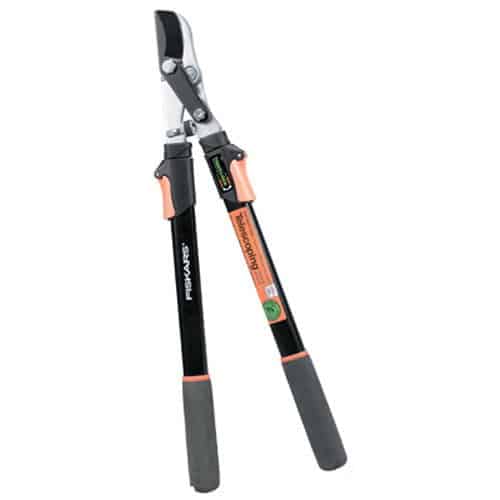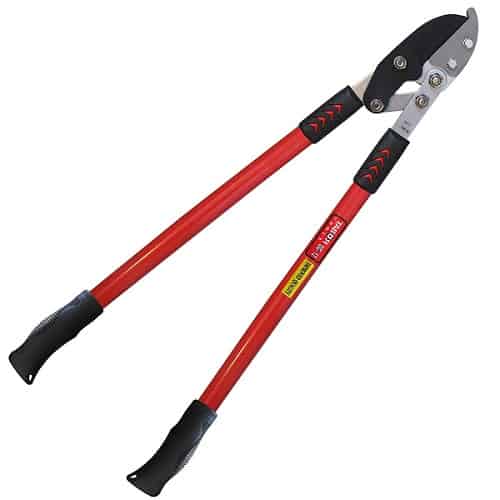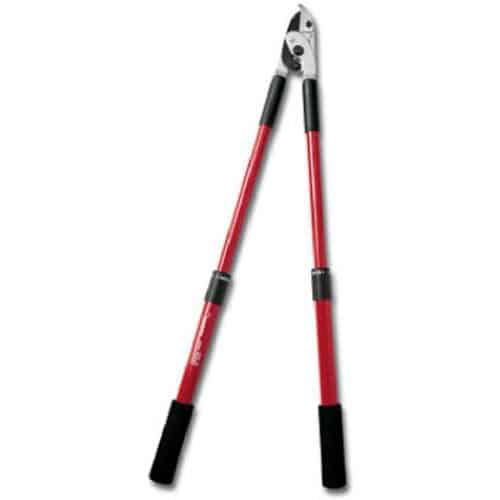Finding the Best Loppers for Homeowners & Gardeners
Everything You Need to Know Before You Trim Those Tree Limbs
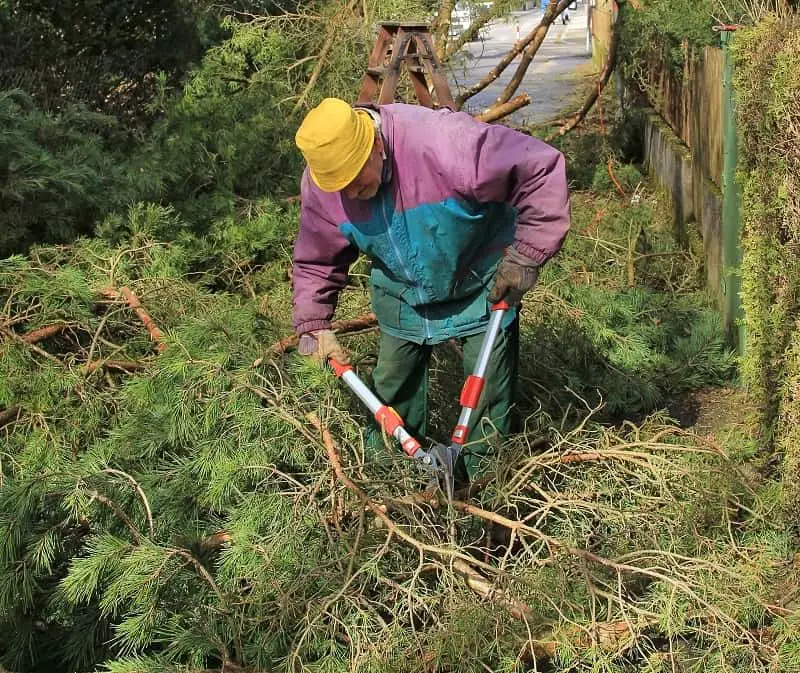
When cutting down trees,a pair of loppers will save you time and effort
Quick Navigation
IF THE TIME HAS COME for you to prune a few branches in your trees that yard that measure more than an inch in diameter...
Do you run out to the shed and grab the pruning shears? Probably not as they are not made to take on such thick limbs. What about one of those gas or electric powered pruning saws? Unless you have dozens of trees to trim every year, buying one of these could be overkill.
A much better choice would be a pair of good loppers, as they can cut limbs up to 2-inches in diameter with ease. Let's take a look at the best loppers for your money.
While we are at it, let's also take a look at what you should be looking for in a pair of loppers so that you don't do what I did and buy the wrong ones the first time.
Choosing the Best Loppers to Fit Your Needs
First, you need to realize that loppers come in a range of sizes, styles, and prices. To a certain extent, they are little more than a pair of pruning shears with longer handles. However, deciding which are the best loppers for you should be based on:
- What type of pruning you plan to do
- How tall, big and strong you are
- How much money you can afford to spend
*Note that I put the cost of the loppers at the bottom of the list.
While cost may play an important role in your final decision, it should never be your first thought, nor should it be your final deciding factor. The reality is that if you try and "cheap out", you are only going to end up being disappointed in the loppers you end up with.
The Different Types Available
To start with, there are two basic types of lopper on the market. These are the anvils style and the bypass style. These terms refer to the cutting blades themselves and how they cut. Both blade types are made for different types of cutting, so be sure to buy the type that best fits your overall needs.
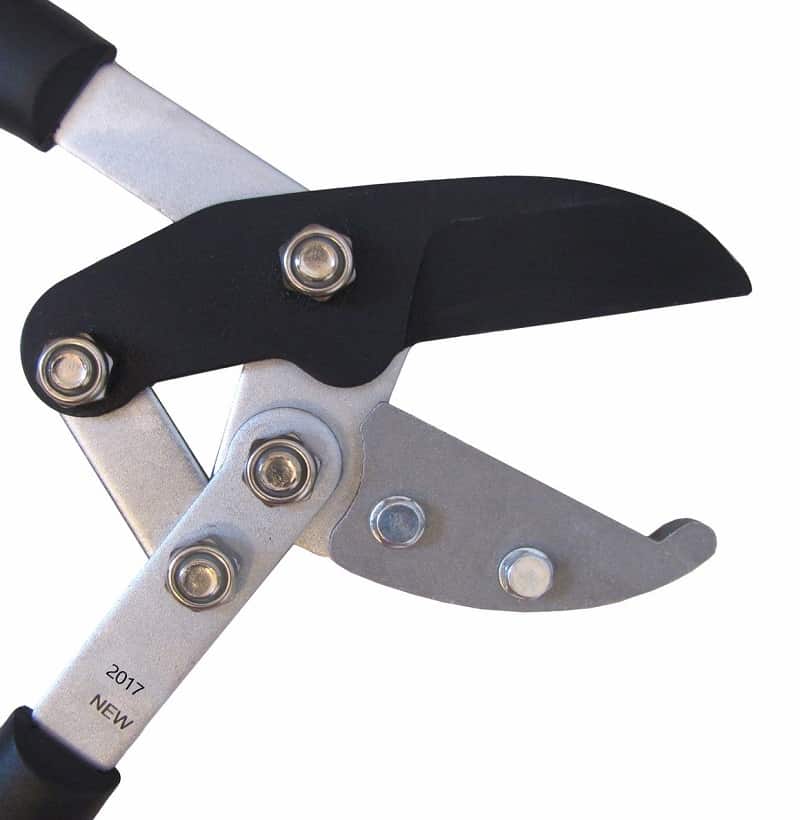
A close up of an anvil lopper action thanks to Tabor Tools. This one also has a compound action you can see on the left
1. Anvil Style Loppers
Anvil style loppers are not as commonly used as they tend to make a rougher cut
- They have a single blade that makes contact with an "anvil", which is a flat steel or nylon plate attached to the other handle.
- They can, by virtue of their design cut thicker branches. However, this type of cutting action tends to crush as it cuts.
- These loppers are better suited to cutting dead limbs or living limbs that you plan to use a saw or bypass loppers to clean up the cut when you are done.

A close up of the bypass action thanks to Tabor Tools
2. Bypass Style Loppers
Bypass style loppers are probably the most commonly used style as they make far cleaner cuts
- They have a pair of blades that cut as they slide past each other.
- They provide a very clean cut.
- Dead or dry branches can bend the blades.
- They do tend to jam, especially when cutting dead wood.
While anvil loppers can cut thicker branches up to 2 inches in diameter, if you plan to cut anything thicker, you may want to invest in a pruning saw.
Pay Close Attention to the Blades
Like most things you buy today, with loppers, you tend to get what you pay for. For the most part, you will find that loppers have steel blades. However, the best loppers have blades that are made from either carbon steel or stainless steel.
- Both stainless steel and high carbon steel blades are less likely to bend or break than cheap steel blades.
- Poor quality steel blades will not hold an edge and will require more frequent sharpening.
- Some blades feature a non-stick coating that can come in handy when dealing with trees that have a lot of sticky sap.
- If you are buying bypass loppers, pay close attention to how close the blades are to each other as they pass. The closer the better.
- Good quality loppers should have an adjuster that lets you set how close the blades are to each other.
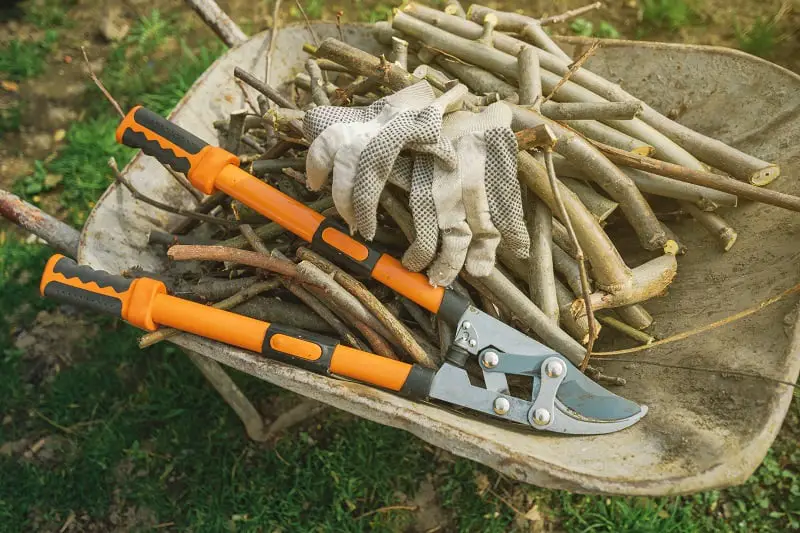
The Different Mechanisms
While some of the less expensive loppers may have a simple pivot, these tend to make the job much harder than it needs to be. The best loppers feature one of three different types of pivoting mechanisms. These mechanisms are designed to reduce the amount of effort needed to cut through the branches.
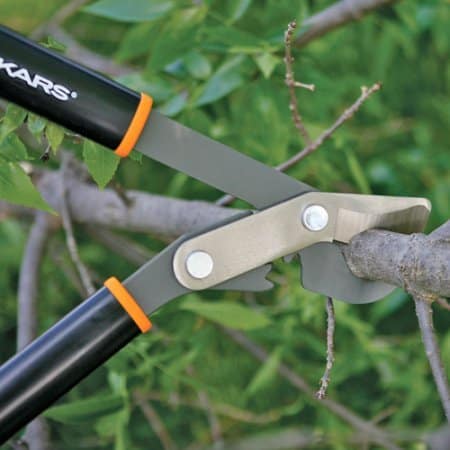
A gear action lopper in action. Image courtesy of Fiskars
1. Gear Action
This style of lopper features a gear mechanism at the fulcrum. The gears are designed to magnify the amount of force you are applying at the handles, making it much easier to cut through thicker branches.
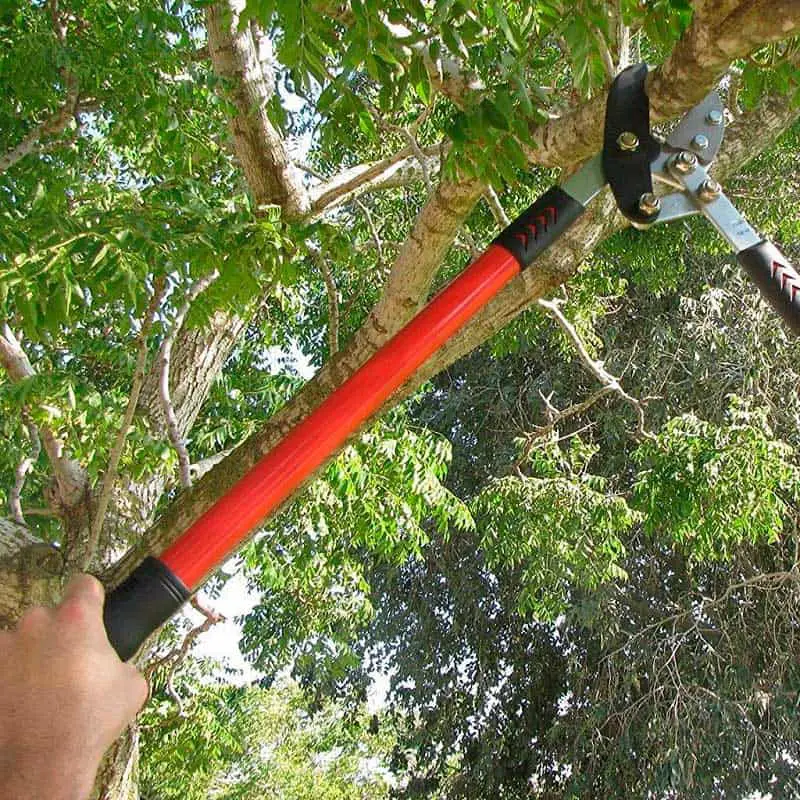
A compound action lopper thanks to Tabor Tools
2. Compound Action
These loppers feature multiple pivot points and a number of moving levers and parts that help to amplify your efforts. With these, the handles do have to be opened wider in order for the blades to reach around the branches you are cutting.
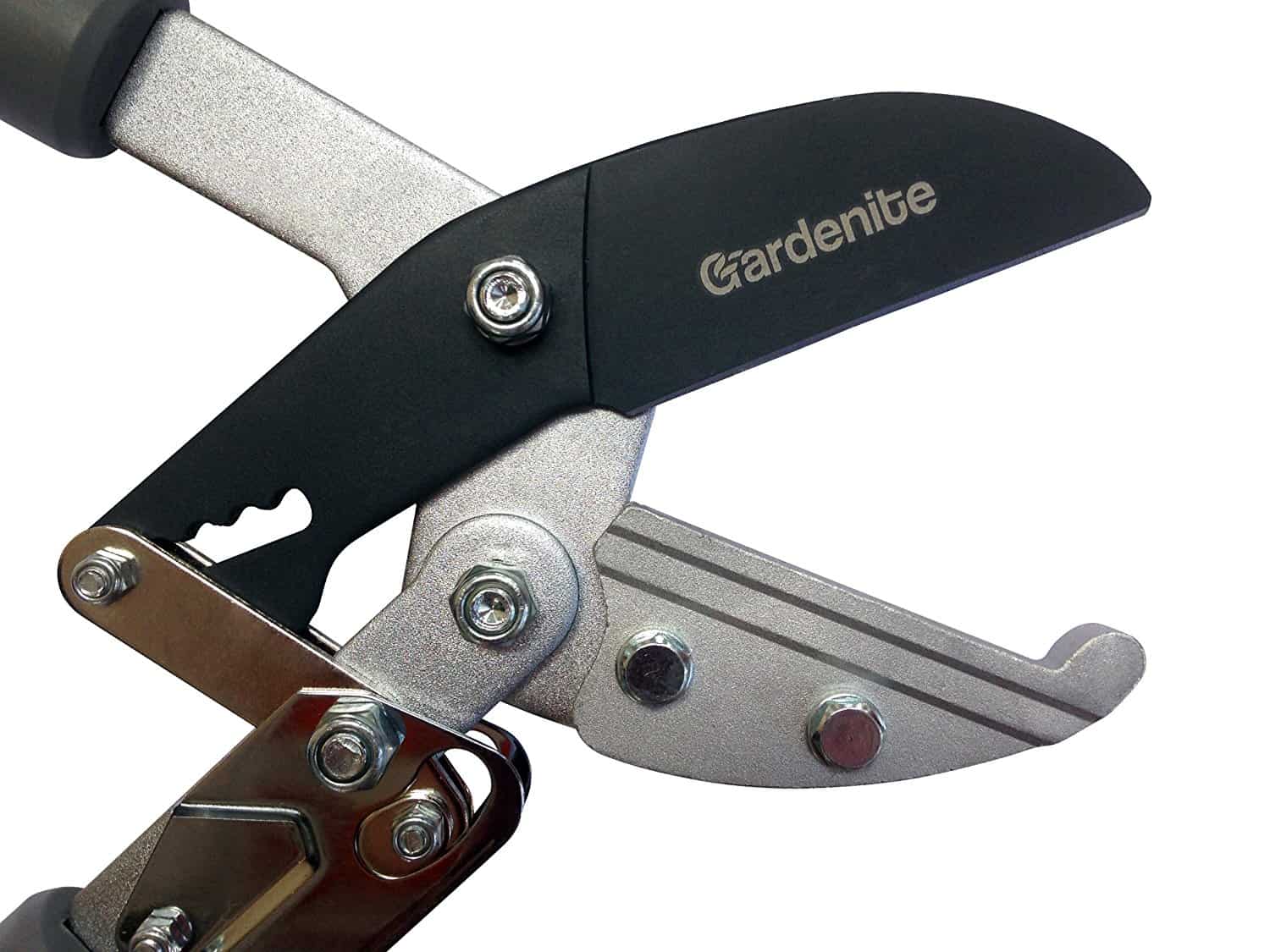
A close up of a ratchet mechanism on a pair of loppers. Thanks to Gardenite
3. Ratcheting Loppers
These are great for those who lack the physical strength to complete a cut in a single shot. Each time you move the handles closer together, the ratcheting mechanism locks them in place. You can then release the handles and squeeze them back together again. This way you get to make the cut in as many easy steps as needed.
Handles
Loppers are available with a variety of handle lengths. These can range from as short as 15 inches to as long as 32 inches or more. Longer handles can give you more leverage, which in turn will make it easier for you to cut through those tougher branches.
However, longer handles are heavier and can be harder to work with. Pick a handle length that you are comfortable working with and will still let you get the job done.
A Word or Two about Telescoping Handles
They can be a great way to compromise as you can slide them in for shorter handles when you need them and then pull them out when you need longer handles. These can be ideal for many pruning situations. But they do tend to be heavier and you need to make sure the locking mechanism works properly as some of the cheaper models don't hold very well.
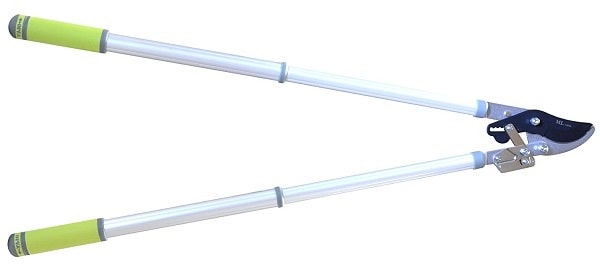
A pair of telescopic loppers with standard style grips, thanks to MLTOOLS
Get a Grip
Most loppers come with some form of grip on the handles. The grips come in a variety of shapes, sizes, and materials. Many of the newer models feature "ergonomically" designed grips that are made to fit your hands and reduce fatigue and stress.
There are soft foam grips (my favorites), contoured grips and more, but the best way to decide which style is right for you is to try a few different styles and brands out for yourself.
How Much Weight Can You Handle?
Most of the weight in a lopper comes from the handles. There are several different types of material in use today:
- Fiberglass - the lightest weight, may flex more than you would like
- Aluminum - almost as light as fiberglass and won't flex
- Wood - middle of the road weight
- Steel - the heaviest handles typically found in professional loppers and those made for cutting thicker limbs
Keep in mind that while heavier duty handles may seem like a better idea, you are likely to find them to be tiring to use if you have a lot of pruning to do.
Other Issues to Consider
There are a couple of other issues worth mentioning if this is your first time buying a decent pair of loppers:
- Do they have some form of stopper or bumper that ensures the closed handles stay far enough apart that your fingers don't end up getting smashed when they cut through the limb?
- Is the cutting capacity going to be big enough to handle the tasks you are buying them for? Most will cut up to 2 inches, but if they are too heavy or the handles are too short to give you the leverage you need, being able to cut up to 2 inches may not do you any good at all.
No matter how you look at it, cost is eventually going to play a role in your final decision. Center pivot loppers are going to be the least expensive but can be the hardest to use.
Geared loppers are going to be more expensive as will compound action loppers, but both can make the job much easier. Fixed length handles will be less expensive than those with telescopic handles, but may be less versatile.
The Top Picks for Best Loppers
So now that you know what you need to consider in your search for the best loppers to meet your needs, let's take a look at my top picks in each category.
Bypass Loppers
These are the ones with two blades that pass by each other making the cut.
MLTOOLS Easy Cut Ratcheting Extendable Bypass Lopper
Handles that extend up to 39 1/2 inches for added power
MLTOOLS Easy Cut Ratcheting Extendable bypass Lopper up to 39-1/2 inch Long - Ratchet Lopper L8230
These ratcheting loppers feature a pair of SK-5 High Carbon Steel blades and a tough ratcheting mechanism. The handles extend up to 39 1/2 inches long and lock firmly into place.
The handles are made from lightweight aluminum and feature non-slip grips for added comfort and safety. They are designed to cut branches up to 1 3/4 inches thick. The ratcheting mechanism offers a 5:1 cutting advantage over standard center pivot loppers.
| Pros | Cons |
| Lightweight aluminum handles | The blades flex at the pivot point |
| SK-5 high carbon steel blades | May not cut branches over 1 1/2 inches without difficulty |
| Ratcheting mechanism offers easier cutting and more power | A little heavy despite the aluminum handles |
Fiskars 25 Inch Extendable Power-Lever Lopper
Compound power lever action gives you double the power
FISKARS 25 Inch Extendable Power-Lever Lopper
If you have thicker branches to prune these compound lever-action loppers may be just the ticket. The Fiskars Power-Lever design doubles your power input in comparison to single pivot loppers. This allows you to easily cut branches up to 1 3/4 inches thick.
The handles extend from 25 to 37 inches to help you reach those high branches and to give you plenty of leverage. The fully hardened steel blade features a low-friction coating that also helps to protect the blades from rust. The steel handles come with Softgrip handles for added safety and comfort.
| Pros | Cons |
| Compound lever action adds plenty of power | Handle locking mechanisms may not lock handles in place |
| Extendable handles help you reach higher and add more leverage | Hardened steel blades are brittle and may break under heavy usage |
| Steel construction won't break | All-steel construction is very heavy |
Anvil Loppers
These feature a single blade that connects with an anvil once the cut is made
Tabor Tools GG12 Compound Action Anvil Lopper
Cuts branches up to 2 inches in diameter with ease
Tabor Tools GG12 Compound Action Anvil Lopper, Chops Thick Branches With Ease
The compound action of these anvil style loppers makes cutting through branches up to 2 inches in diameter a breeze. The blades are made from high-carbon steel and are covered with a non-stick coating.
The handles are a fixed 30-inches long to give you all the power you need to make a wide variety of cuts and have rubberized comfort grips that provide you with a firm grip for added safety.
The compound action of these loppers multiplies your efforts by a factor of three over single pivot loppers.
| Pros | Cons |
| High carbon steel blades have a non-stick coating | Carbon steel blades will rust |
| Anvil style lets you cut thicker branches | Poor balance adds extra strain to hands and arms |
| Rugged design built to last | Fixed handle length may not work for every job |
Corona FL 3450 Compound Action Anvil Lopper with Extendable Handles
Heat treated cutting head for added durability
Corona FL 3450 Compound Action Anvil Lopper with Extendable Handles
The handles of this compound style anvil lopper extend from 21 to 33 inches, making them more adaptable than most on the market. The fully heat-treated head features a PTFE (Teflon) coated blades for fast, easy, and clean cuts every time.
To help keep the weight down, the handles are made from fiberglass. This lopper is designed to cut branches up to 1 1/2 inches in diameter.
| Pros | Cons |
| Lightweight fiberglass handles | May not cut certain woods at 1 1/2 inches in diameter |
| Handles extend from 21 to 33 inches | Lip on the end makes it hard to see if lopper is positioned properly when cutting |
| Compound action makes cutting easier | Extendable arms hard to keep locked in place |
Gear Style Lopper
Gear technology adds tons of power when cutting through branches
Fiskars 32 Inch PowerGear2® Lopper
Gear action gives you triple the cutting power
Fiskars 32 Inch PowerGear2 Lopper
The patented PowerGear2® technology used in these loppers from Fiskars gives you 3 times the cutting power of a conventional lopper. You can use this power to cut through branches up to a full 2 inches in diameter.
The gear and cam mechanisms are designed to give you maximum power when you are in the middle of your cut where the branch is the thickest. The blades are made from premium quality steel with a low-friction coating an improved geometry to help make cutting in tight spots easier.
| Pros | Cons |
| Gear and cam mechanism makes cutting easier | Fixed length handles |
| Up to a full 2-inch capacity | Blades may break on larger branches |
| Low-friction coating helps make cutting easier | Handles must be opened to almost 180 degrees to fit over larger branches |
The Final Cut
Finding the best loppers to fit your needs is not an easy task as there are so many to choose from. You may find you need to have more than one pair on hand to take care of all your needs.
I personally love the Fiskars 25 Inch Extendable Power-Lever Lopper because they offer plenty of power and I personally prefer bypass style loppers as they let me get in closer to the end of the limbs.
If you have enjoyed reading about the different types of loppers, please let me know.
If you have any information you would like to see here, please contact us here.
Let everyone know you enjoyed reading this on Facebook and Pinterest.
Thank you for reading this.

